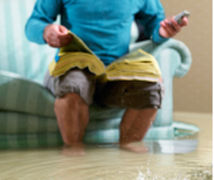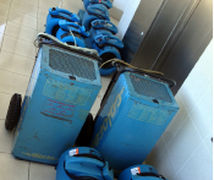Top Tips
TIP 1: Stop the water leak if possible
The first course of action is to halt or limit the impact of the flood damage by stopping or reducing the ingress of water into the home or property.
If from a burst water pipe or burst hot water service, you will need to locate the nearest water supply tap and shut it off. In certain instances, this may require a professional plumber and/or the building manager.
If there is storm damage to ceilings or roofs, or water ingress via balconies or cracks in wall cavities you may need the assistance of a builder or water proofer to locate the source of the leak.

TIP 2: Secure your family and valuables
We’re at your front door in less than 1 hour from when you call us if you are in the Sydney Metropolitan area.
We know how important it is to begin the flood restoration process quickly so that your wet carpets are returned to their dry state as soon as possible.
Our team is always ready to rush to your aid, so don’t wait for your insurer’s flood restorer (sometimes they take days to get to you!) – get Mr Flood to your door now.
TIP 3: Call us on 1300 673 566 any time 24/7
Our trained technicians are available 24 hours a day, 7 days a week, 365 days a year and are ready to attend your site in under an hour in most cases.
During the initial phone call, you’ll speak directly to a trained flood restoration technician who will offer you additional advice and provide an estimated arrival time for our flood restoration team.
TIP 4: Contact relevant other parties
(landlord, agent, building manager, strata etc.)
In many instances you may need to contact other relevant parties and advise them of the flood damage. In strata managed properties the strata company will need to be advised as there will often be aspects of the flood restoration that they will need to approve and pay for.
For example, even if your wet carpets and underlay need restoring the strata may be responsible for covering costs for structural drying and restoration of ceilings, walls and concrete or wooden subfloors within your lot. If the cause of the flood is from broken plumbing, strata may cover the entire cost of the restoration.
If you are a rental tenant, we recommend contacting your landlord, agent or property manager immediately. Unless you were directly responsible for the flooding the costs for the restoration may be the responsibility of the landlord or strata. The building manager or body corporate representative may also need to be contacted.
Most strata managed properties list these contacts on the notice board in the common area or foyer. If you cannot contact your agent your landlord’s information is sometimes listed in your rental tenancy agreement.
TIP 5: Move floor level items to a safe, dry location
Water extraction is the first stage of the carpet drying process. For this to work quickly and effectively we need to have access to the entire flooded floor area.
If safe to do so, move all floor level furniture, clothing and other personal items to a dry area of the home. If you have stained wood furniture (not laminate) on wet carpet move it somewhere else and/or place plastic between it and the carpet to avoid the wood stain marking the carpet as this cannot be restored.
TIP 6: Ventilate flooded areas
(clear blocked drains, open doors and windows)
If the weather and security permits, open up the flooded area so that the moisture can be allowed to escape to the outside environment. Check drains to ensure they are unblocked.
After the water extraction phase of the flood restoration is complete, the drying process will then require evaporation to occur to remove all remaining moisture.
If the weather is warm and low in humidity additional ventilation from opening doors and windows will speed up the restoration process. If weather is cold and high in humidity Mr Flood will employ our professional dehumidification equipment to create the correct environment for fast drying.
TIP 7: Arrange direct access for Mr Flood technicians
(parking, building access etc.)
Our technicians will need direct access to the flooded area and will be required to use our extraction machines and carpet drying air movers and dehumidifiers.
To assist and make the process as quick as possible you may need to arrange access to car parks and security access to buildings and elevators. Ensure there is a clear pathway directly to the flooded area.

TIP 8: Consider alternate short term living arrangements
(severe flooding cases)
In most flooding cases after the water extraction process we will be installing drying equipment on site to provide additional drying to carpets, underlay, subfloors and walls.
While completely safe, this equipment can sometimes be too noisy for people to live with comfortably for a few days. Also, the carpets may be ‘float dried’ which requires rooms to be isolated for access for up to a week in severe cases.
You may need to consider alternate arrangement for accommodation until the drying process and water restoration area are 100% completed. This can take from two to seven days depending on the severity of the water damage.
TIP 9: If the water is sewerage or otherwise contaminated
If you suspect that the flood damage contains sewerage or other contaminated water sources evacuate the area immediately, as it poses an immediate health risk to anyone who enters the area.
Wait until Mr Flood technicians arrive on site and assess the damage in proper protective clothing. Also, foot traffic through contaminated areas spreads this to other areas that will also then need to be restored.
In most cases any porous material that is exposed to sewerage or otherwise contaminated flood water will need to be disposed of and replaced.







